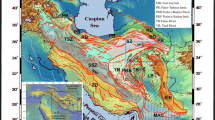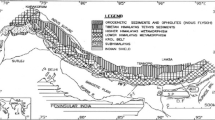Abstract
Investigations of micro- and low-magnitude earthquakes in the Kangra-Chamba region of the NW Himalaya were performed to evaluate the relationship between earthquake source, seismicity, stress drop, tectonics, and structure. The seismic events were recorded by a dense local network of 21 permanent/temporary stations during 2004–2005. The earthquake source parameters using spectral analysis were calculated for refined epicenters obtained by Local Earthquake Tomography method. We applied two approaches of spectral analysis for earthquake data and the box-counting fractal dimension for structural elements in order to understand the seismogenesis of the region properly. These two methods giving inter-dependable results were used for the study area that extends from latitude 31.5°N–33.5°N and longitude 75.5°E–77.5°E in the epicenter zone of devastating 1905 Kangra earthquake. The seismic moment of these earthquakes (1.5 ≤ Mw ≤ 4.8) is between 1.21E + 18 dyne-cm and 1.44E + 23 dyne-cm causing circular deformation of radius in the range 0.12–1.15 km based on Brune’s circular model. The study reveals that low value for the capacity fractal dimension (D 0 of 0.678) and seismically intense clustering of 135 earthquakes with low stress drops generally below 10 bar but up to 26 bar. Evaluated low stress drop of small size earthquakes and low D 0 of structural elements has led to the identification of nature of brittleness of the crust and proneness to high strain accumulation that indicates the presence of an asperity/barrier in the fault zones. The variation of b value and 3D seismic velocities supports the presence of asperity zone.







Similar content being viewed by others
References
Aki K (1981) A probabilistic synthesis of precursor phenomena. In: Simpson DW, Richards PG (eds) Earthquake Prediction, Maurice Ewing Series 4, AGU 566–574
Aki K (1984) Asperities, barriers, characteristic earthquake and strong motion prediction. J Geophy Res 89:5867–5872
Allen TI, Gibson G, Brown A, Cull JP (2004) Depth variation of seismic source scaling relations: implications for earthquake hazard in southeastern Australia. Tectonophysics 390:5–24
Angulo-Brown F, Ramirez-Guzman AH, Yepez E, Rudoif-Navarro A, Pavia- Miller CG (1998) Fractal geometry and seismicity in the Mexican subduction zone. Geofisica Inter 37:29–33
Archuleta R, Cranswick E, Mueller C, Spudich P (1982) Source parameters of the 1980 mammoth lakes, California, earthquake sequence. J Geophy Res 87:4595–4607
Arora BR, Gahalaut VK, Kumar N (2012) Structural control on along-strike variation in the seismicity of the northwest Himalaya. J Asian Earth Sci 57:15–24
Baltay A, Ide S, Prieto G, Beroza G (2011) Variability in earthquake stress drop and apparent stress. Geophy Res Lett 38:L06303. doi:10.1029/2011GL046698
Banerjee P, Burgmann R (2002) Convergence across the northwest Himalaya from GPS measurement. Geophy Res Lett 29(13):301–304
Bhattacharya SN, Kayal JR (2005) Seismicity of the Himachal Himalaya: constraint from local seismic network. Geo Survey Ind Special Publication 85:71–79
Bilham R, Gaur VK, Molnar P (2001) Himalayan seismic hazard. Science 293:1442–1444
Brune JN (1970) Tectonic stress and the spectra of seismic shear waves from earthquakes. Geophy Res Lett 75:4997–5009
Carlson CA (1991) Spatial distribution of ore deposits. Geology 19:111–114
Dubey AK (2004) Structural evolution of the Himalaya: field studies, experimental models, and implications for seismicity. Him Geol 25(1):33–50
Gansser A (1964) Geology of the Himalayas Interscience. New York, p 289
Gitis V, Yurkov E, Arora BR (2008) Analysis of seismicity in North India. Russian J Earth Sci 10:ES5002. doi:10.2205/2008ES000303
Gonzato G (1998) A practical implementation of the box-counting algorithm. Comp Geosci 24:95–100
Gonzato G, Mulargia F, Marzocchi W (1998) Practical application of fractal analysis: problems and solutions. Geophy J Int 132:275–282
Hirata T (1989) Fractal dimension of fault systems in Japan: fractal structure in rock fracture geometry at various scales. Pure App Geophy 131:157–170
Idziak A, Teper L (1996) Fractal dimension of faults network in the upper silesin coal basin (Poland): preliminary studies. Pure App Geophy 147:239–247
Joshi M, Rai JK (2003a) An appraisal of models for inverted himalayan metamorphism. Memoir vol J Geol Soc Ind 52:359–380
Joshi M, Rai JK (2003b) Fractal dimension as a new measure of Neotectonic activity in Kakrighat area, Kumaun Himalaya. J Geol Soc Ind 61:664–672
Kayal JR (2001) Microearthquake activity in some parts of the Himalaya and the tectonic model. Tectonophysics 339:331–351
Khattri KN (1987) Great earthquakes, seismicity gaps and potential for earthquake disaster along Himalaya plate boundary. In: Mogi K and Khattri KN (Ed). Earthquake Prediction. Tectonophysics 138:79–92
Kissling E (1995) Program VELEST User’S guide-short introduction (second draft). Institute of Geophysics and Swiss Seismological Service, ETH-Hoenggerberg, Zurich, Switzerland, pp 1–26
Korvin G (1992) Fractal models in the earth sciences. Elsevier, Amsterdam, p 369
Kumar N (2010) Quantification of seismic regimes of Kangra-Chamba region of NW Himalaya. Ph. D. Thesis, Indian Institute of Technology, Roorkee, India pp. 300
Kumar N, Parvez IA, Virk HS (2005) Estimation of coda wave attenuation for the NW Himalaya region using local earthquakes. Phy Earth Sci Int 151:243–258
Kumar N, Sharma J, Arora BR, Mukhopadhyay S (2009) Seismotectonic-model of the Kangra-Chamba sector of northwest Himalaya: constraints from joint hypocenter determination and focal mechanism. Bull Seismol Soc Am 99(1):95–109
Kumar N, Paul A, Mahajan AK et al (2012) The Mw 5.0 Kharsali Garhwal Himalaya earthquake of 23 July, 2007 source characterization and tectonic implications. Curr Sci 102(12):1674–1682
Kumar N, Arora BR, Mukhopadhyay S, Yadav DK (2013) Seismogenesis of Clustered Seismicity beneath the Kangra-Chamba sector of northwest Himalaya: constraints from 3D local earthquake tomography. J Asian Earth Sci 62:638–646
Lyubushin AA, Arora BR, Kumar N (2010) Investigation of seismicity in western Himalaya. Geophy Res 11(1):27–34
Mahajan AK, Kumar N, Arora BR (2006) Quick look isoseismal map of 8 October 2005 Kashmir earthquake. Curr Sci 91(3):356–361
Mahmood H, Ingham JM (2011) Seismic vulnerability assessment of Pakistan unreinforced masonry buildings at a national scale. Seismol Res Lett 82(5):676–685
Mandelbrot BB (1983) The fractal geometry of nature. Freeman, New York
Mandelbrot BB (1985) Self-affine fractals and fractal dimension. Phy Scripta 32:257–260
Middlemiss CS (1910) The Kangra earthquake of 4 April 1905. Mem Geol Soc Ind 38:409
Ogata Y (1999) Seismicity analysis through point-process modeling: a review. Pure App Geophy 155:471–507
Okubo PG, Aki K (1987) Fractal geometry in the San Andreas fault system. J Geophy Res 92:345–355
Powers PM, Lillie RJ, Yeats RS (1998) Structure and shortening of the Kangra and Dehra Dun reentrants, Sub-Himalaya. India. Geol Soc Am Bull. 110(8):1010–1027
Prasad BJ, Klemperer SL, Rao VV (2011) Crustal structure beneath the Sub-Himalayan fold-thrust belt, Kangra recess, northwest India, from seismic reflection profiling: implications for Late Paleoproterozoic orogenesis and modern earthquake hazard. Earth Planet Sci Lett 308:218–228
Raines GL (2008) Are fractal dimensions of the spatial distribution of mineral deposits meaningful? Nat Resources Res 17:87–97
Raiverman V (2002) Foreland sedimentation in himalayan tectonic regime: a relook at the orogenic process. Bishen Singh Mahendrapal Singh, Dehra Dun 378p
Ram A, Roy PNS (2005) Fractal dimensions of blocks using a box-counting technique for the 2001 Bhuj earthquake, Gujarat, India. Pure App Geophy 162:531–548
Roy PNS, Mondal SK (2009) Fractal nature of earthquake occurrence in northwest himalayan region. J Ind Geophy Union 13(2):63–68
Roy PNS, Mondal SK, Joshi M (2012) Seismic hazards assessment of Kumaun Himalaya and adjacent region. Nat Hazards. doi:10.1007/s11069-012-0235-0
Rudnicki J, Kanamori H (1981) Erects of fault interaction on moment, stress drop, and strain energy release. J Geophy Res 86:1785–1793
Satyabala SP, Yang Z, Bilham R (2012) Stick-slip advance of the Kohat Plateau in Pakistan. Nature geosci. doi:10.1038/NGE01373
Sharma ML, Wason HR (1994) Occurrence of low stress drop in the Garhwal Himalayan region. Phy Earth Planet Inter 85:265–272
Stork AL, Ito H (2004) Source parameter scaling for small earthquakes at the Western Nagano 800-m-Deep Borehole. Central Japan. Bull Seismol Soc Am. 94(5):1781–1794
Sukmono S, Zen MT, Hendrajjya L, Kadir WGA et al (1997) Fractal pattern of the Sumatra fault seismicity and its application to earthquake prediction. Bull Seismol Soc Am 87:1685–1690
Sunmonu LA, Dimri VP (2000) Fractal geometry and seismicity of Koyna-Warna, India. Pure App Geophy 157:1393–1405
Thakur VC (1998) Structure of the Chamba nappe and position of the main central thrust in Kashmir Himalaya. J Asian Earth Sci 16:269–282
Thurber CH (1993) Local earthquake tomography velocities and Vp/Vs—theory. In: H.M Iyer and K. Hirahara, Editors: Seismic tomography, Champan and Hall, London 563–580
Turcotte DL (1997) Fractals and Chaos in Geology and Geophysics: Cambridge University Press (2nd Ed). New York, 398p
Yadav DK, Kumar N, Paul A (2009) Recent seismicity and stress pattern in NW Himalaya. Himalayan Geol 30(2):139–145
Acknowledgments
The authors are thankful to Director, WIHG, Dehradun, for his kind permission to publish this work. Partly the work is based on the thesis of NK and he thanks his supervisors Profs V.N. Singh, B.R. Arora and S. Mukhopadhyay. The authors also thank Dr. A. K. Dubey for valuable suggestions for improving the manuscript. The MoES, New Delhi, India, is thankworthy for sponsored projects (MoES/P.O.(Seismo)/NPEP(15)/2009 and MoES/P.O.(Seismo)/GPS/60/2006). NK thanks ICTP Trieste, Italy, for providing Junior Associateship. Two anonymous reviewers are thanked for constructive evaluation.
Author information
Authors and Affiliations
Corresponding author
Electronic supplementary material
Below is the link to the electronic supplementary material.
Rights and permissions
About this article
Cite this article
Kumar, N., Yadav, D.K., Mondal, S.K. et al. Stress drop and its relation to tectonic and structural elements for the meizoseismal region of great 1905 Kangra earthquake of the NW Himalaya. Nat Hazards 69, 2021–2038 (2013). https://doi.org/10.1007/s11069-013-0793-9
Received:
Accepted:
Published:
Issue Date:
DOI: https://doi.org/10.1007/s11069-013-0793-9




